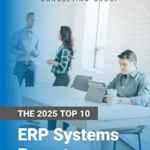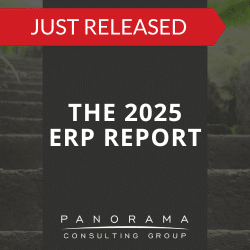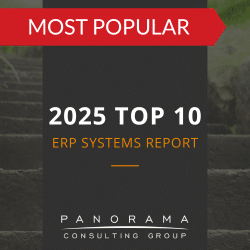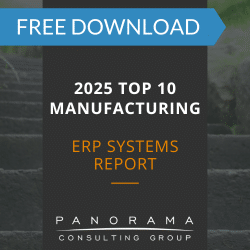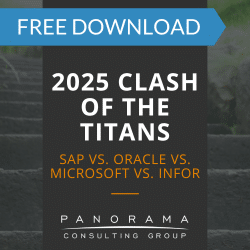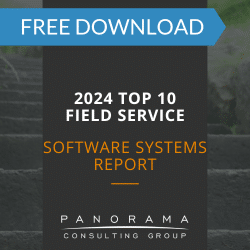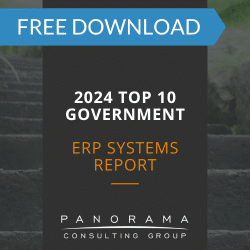- ERP total cost of ownership includes both direct expenses, like software and implementation, and indirect costs, such as support and change management.
- The ability to minimize ERP costs depends on early planning, careful vendor evaluation, and alignment between business needs and system capabilities.
- Vendor negotiations, customization requirements, and reliance on third-party consultants are key variables in estimating ERP total cost of ownership.
If you’re considering implementing a new ERP system, CRM system, or SCM system, you’re probably wondering how much it’s going to cost.
We’ve got some good news and some bad news. The good news is that this is the topic of today’s post. The bad news is that we’re not going to sugarcoat it – there are more ERP costs than you might think.
Sit back as we guide you through the process of estimating ERP total cost of ownership (TCO), including both direct and indirect costs.
Estimating Direct ERP Costs
Software Costs
This includes annual maintenance and support fees, as well as license fees, which vary depending on the size and complexity of your organization.
Additionally, you need to factor in the cost of customization and any additional software modules or add-ons you may need to support your business processes.
To minimize software costs, you should carefully evaluate ERP vendors and weigh your deployment options (hosted vs. SaaS, etc.). Then, work with an ERP selection consultant to negotiate favorable terms.
Software Selection & Process Improvement Case Study
In helping the client get its project back on track, one of our primary focus areas was decreasing their customization needs by improving their processes to align with the system's best practices.
Implementation Costs
ERP implementation costs include expenses associated with planning, project management, and deployment, as well as any hardware or infrastructure upgrades.
Start by identifying the scope of the implementation. What modules and features will you need? Are you considering AI in your ERP system? What business processes will the new software impact?
Then, determine what internal resources and third parties you will need, while estimating the hourly rates of these resources.
Finally, consider hardware and infrastructure costs related to servers, storage devices, network equipment, and other technical components.
To control your budget, you should carefully plan and closely manage the implementation to reduce the risk of ERP failure and ensure the project stays on track.
Estimating Indirect Costs
Support and Maintenance Costs
These are ongoing expenses associated with keeping the ERP system running smoothly. Whether it’s technical support, bug fixes, or software updates, you’ll inevitably be calling on your vendor to assist you.
While your spend will vary widely depending on the vendor and the complexity of the system, you can get an estimate by requesting quotes from vendors and factoring in costs associated with third-party support and internal IT resources.
To minimize ongoing support and maintenance costs, it’s important to invest in system monitoring and optimization in the short term to ensure your system continues to meet your changing business needs.
Organizational Change Management Costs
One often overlooked item is organizational change management (OCM). During an ERP project, OCM focuses on preparing employees for the changes that will occur as a result of the new system.
The OCM costs you might incur include expenses related to ongoing end-user training and communication, as well as resistance management.
To estimate organizational change management costs, you should start by understanding the scope of the change. Identify the areas of your organization that will be impacted by the new system, and document all role and responsibility changes. Then, consider the resources you will use to staff your change management team. This might include both internal staff and external consultants.
To minimize the cost of project delays due to poor change management, it’s important to start planning OCM activities early and involve employees in the ERP selection process. Engaged employees are less likely to resist change, especially if they’ve had a say in the project direction.
Data Conversion Costs
Data conversion is the process of moving data from your existing systems into the new ERP system. This process includes activities such as data analysis and mapping, data cleansing, and data migration.
Data conversion can be complex and may require the assistance of external consultants, so consulting fees are a key consideration.
To minimize these costs, you must develop a comprehensive data conversion plan as early as possible. This means identifying critical data sets, determining which data should be migrated, and assessing data quality long before go-live. It also means establishing clear data governance policies and assigning data ownership to ensure accountability across departments.
Integration Costs
Integration with other systems can be expensive, especially if your organization has a complex IT infrastructure.
Many organizations integrate their ERP system with existing enterprise software, hardware systems, and third-party applications. Sometimes, this means developing custom interfaces and data integration solutions.
To minimize integration costs, it’s important to select a system with native integrations or choose a more comprehensive solution that allows you to retire existing legacy systems.
The Final Step: Estimating ERP Total Cost of Ownership
If you want to successfully manage your ERP implementation budget, you must consider all the factors mentioned above, not just in the immediate term, but over the expected life of the system.
Once you’ve estimated your ERP total cost of ownership, your next task is estimating the business benefits you expect to realize. Only then can you calculate the figure that executives really care about: return on investment.
If you’re ready to develop a business case that convinces decision makers to invest in new ERP software, contact our ERP implementation consultants below.
